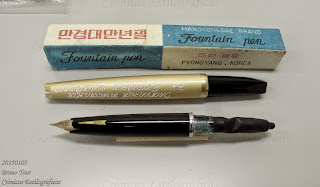The history of fountain pens in Spain is the story of a frustration—a big number of operations that failed to create a sustainable activity.
Inoxcrom and, to a much lesser degree,
STYB were the only survivors of the more or less glorious days of Spanish pens in the 1950s and 1960s.
However, in recent years, several small pen brands have appeared in Spain to cater the stylophile craving for more
artisanal writing tools.
Estilográficas Clavijo and
Gimena are two examples of them.
 Romillo Essential.
Romillo Essential.
The better known of all those new companies is, however,
RomilloPens. The Romillo family founded the brand in 2007 and after a couple of years of experiments, the RomilloPens Essential was launched. Since then, about 10 models have been produced. All of them save the latest arrival called The Celluloid Collection, are made of German ebonite.
 Two Romillos with Bock nibs in sizes 6 and 8.
Two Romillos with Bock nibs in sizes 6 and 8.
Initially, all the nibs were made by Bock –sizes 6 and 8. After some years, in 2012, they started the production of a flexible nib, the K nib. Apparently very flexible, there are
reports questioning the ability of the feed to provide the required inkflow. Starting in 2013, RomilloPens makes its own nibs (sizes 7 and 9), albeit feeds are still provided by Bock.
The philosophy of the company is to make pens resembling old models from the 1910s and 1920s using traditional materials and implementing arcane filling systems, although cartridge and converters are an available option for some models. RomilloPens claims all its pens were
made by hand—obviously an exaggerated claim as lathe and files are in order to machine the ebonite. However, being made to order allows for a great deal of customization.
The final result is an attractive product with a steep price. In fact, for an average of EUR 1000, many an aficionado might, in fact, prefer a real vintage pen in pristine condition to a newly made pen without the glamour and tradition of a well known name.
 The flagship of RomilloPens is the model Nervión. On the image, the version made of terracota ebonite with a size 8 nib by Bock.
The flagship of RomilloPens is the model Nervión. On the image, the version made of terracota ebonite with a size 8 nib by Bock.
This is a risky initiative, and a brave one too. Can the market support it? Time will tell. This luxury market is very competitive; most pen companies have luxury models, and there are some small operations specifically targeting this high-end sector. And at the end,... Montblanc wins.
NOTE ON THE NAMES: The name of the pen brand is, actually, RomilloPens, and is owned by the company Pixeline S. L. Romillo is the name of the founding family. RomilloPens, however, sounds strangely artificial in Spanish (probably in English too) and I tend to use the family name, Romillo, as the brand name.
Romillo Nervión Terracota – Pilot Blue
Bruno Taut
Madrid, November 27th, 2014
etiquetas: España, mercado, RomilloPens, Bock

































